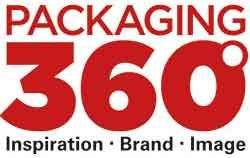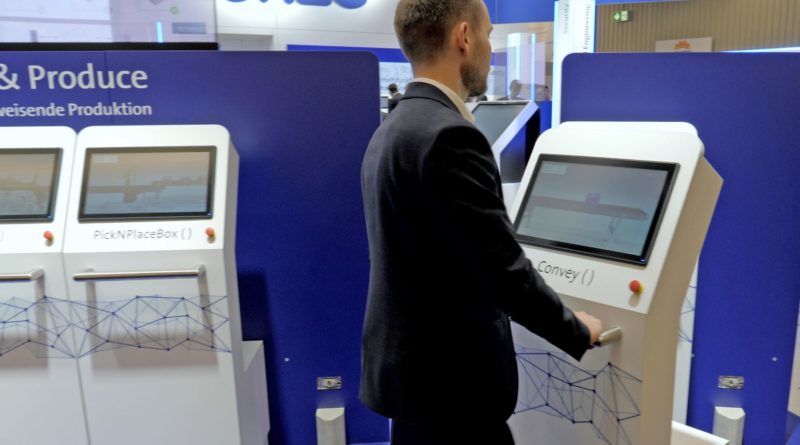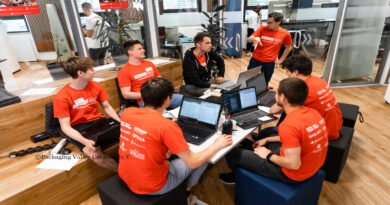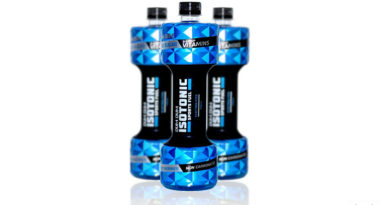Plug and go!
It's a long-cherished dream: machines that can be easily connected to each other. This undertaking is still very complex. But innovative standards open up new perspectives.
The trolleys from the Lenze Group can be quickly rearranged. Each trolley represents a machine with a specific function: Infeed, Pick&Place, Packaging, Paletizer and Outfeed. The machines are digitally simulated, but the interfaces are real. With its showcase, the manufacturer and developer of drive technology and automation was at SPS IPC Drives in Nuremberg in November 2018 and at the Hanover Fair in 2019. It is a feasibility study of what is already possible with today’s technology. “If I want to connect machines with each other today, I don’t want to have different stand-alone solutions next to each other, I want the machines to talk to each other and coordinate,” says Patrick Bruder, Global Business Development Manager Automation at Lenze. “For this, I need certain interfaces between the machines. These interfaces vary from manufacturer to manufacturer, which means that I have to clarify each time which data is transferred and which formats are used. Are the interfaces compatible? Can I integrate the machines into my production line?” Coordinating the machines is still very complicated. Not only do they use different communication methods, they also collect different information. Although this problem can be solved through elaborate engineering, the result is that commissioning accounts for up to a quarter of the total investment. New standards promise to significantly reduce these costs.
In the industry there is now a common standard in the form of the Open Platform Communications Unified Architecture (OPC UA) and the Companion Specification PackML for machines in the packaging industry. While OPC UA provides the technology for data transmission, Companion Specifications define which data is transferred. The German Mechanical Engineering Industry Association (VDMA) is leading the development of Companion Specifications. For the exchange between machines to work, they have to use a standardised Companion Specification. Machines equipped with this standard are compatible with each other in principle. The additional programming effort is significantly reduced.
Lenze has now gone one step further. The part that has been missing until now is the shifting the focus from the machine to its capabilities,” says Bruder. For example, a conveyor belt could have the job of transporting a thing from A to B. But perhaps the same operation could be performed much better by a robot. This shift in focus means that the conveyor belt could then be replaced much more easily by the robot – without having to change anything in the software.
Focus on innovative industry 4.0 concepts
The Industrial Automation Division of the Fraunhofer Institute for Optotronics, Systems Engineering and Image Exploitation (IOSB-INA) in Lemgo has been working on improving the networking of machines since 2011. The OPC UA standard has been known here for years and is used, among other things, in SmartFactoryOWL, a joint initiative of the Technical University of East Westphalia-Lippe and Fraunhofer IOSB-INA, to demonstrate industry 4.0 concepts. “The fact that interest in this technology is currently growing is due to the fact that it has reached a certain level of maturity,” says Florian Pethig, Group Leader Big Data Platforms. However, the devil is in the detail. For example, older machines cannot always cope with this standard.
“There is the option of equipping older machines with OPC UA,” he explains. The process is called retrofitting. This can be done via Internet-of-Things gateways, for example. “But these gateways only allow the machines to communicate with each other,” says Pethig. “The second part, the information layer, is more complicated. This is because the older machine may not be able to evaluate certain information or use other parameters.” Additional programming is still necessary here. “You don’t get that for free,” he says. In addition: one installation of OPC UA may not be the same as another. In less expensive devices, such as small sensors, often only limited OPC UA functionality is available. “However, this will sort itself out in the coming years,” Pethig expects. “Even small devices are becoming more resource-efficient and powerful from year to year, so this will soon no longer be a challenge.”
Plug & Produce delivers higher productivity
The advantage of OPC UA is that it is not tied to a specific manufacturer. This makes it an open standard, and makes it interesting for many vendors. This distinguishes the technology from proprietary systems. For a long time, manufacturers have tried to use this to establish and maintain their supremacy in the factories. The strategy behind it is that if machines are not compatible across manufacturers, the end user has to decide which technical ecosystem to turn to – and is tied by this decision. However, this thinking breaks down in the long term.
The advantages of Plug & Produce for end users are obvious: they can react quickly, adapt their machine park to market requirements, and convert their production. However, reality still needs to catch up. “At the moment, the market doesn’t offer this yet,” says Matthias Kühn, Head of Automation Engineering Technology at Beiersdorf AG. “That’s why we’re trying to work with machine manufacturers to make Plug & Produce possible.” The reason for this approach procedure is clear, according to Kühn. “With an increasing number of products and variants, our production lines need to become more agile and flexible.”
For example, he could imagine one day having three filling machines and ten different labellers in one hall, with their strengths in different functional areas. “I could then use the best machine for each product. In the best case scenario, it wouldn’t matter which manufacturer the machine came from.” But he feels the manufacturers are having a hard time with this. “The fact is that even machines from one single company don’t always work with each other,” says Kühn, noting that different interfaces are frequently a problem, even in this situation. Line integration is also often a problem, right up to different operating concepts and visualisation. However, Kühn is confident that the issue of Plug & Produce will play an increasingly important role. He does, however, believe that manufacturers will have to increasingly open themselves up to standardisation. “That would be a win-win situation for everyone.”




